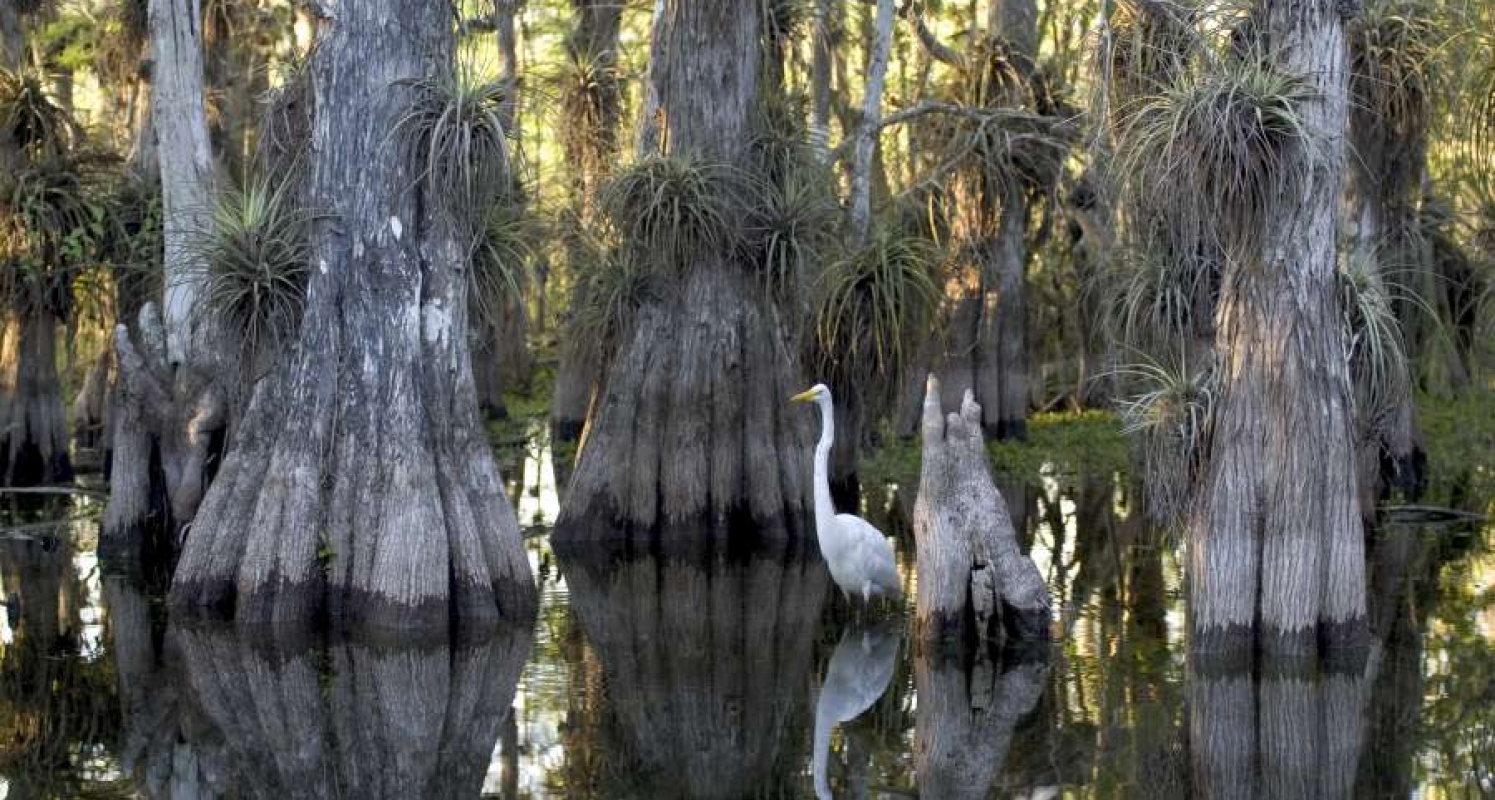With its beautiful landscapes and ideal weather, it’s no wonder Naples, Marco Island, and the Everglades is a favorite Florida destination for wildlife enthusiasts. From the migratory birds that visit the Paradise Coast each winter to the alligators, panthers, and other creatures that know better than to leave the Florida sunshine, here are some of the top places in Paradise to see a variety of awe-inspiring fauna and spot Wildlife in Naples, Marco Island, and teh Everglades.

The Everglades & Ten Thousand Islands
The iconic Everglades National Park and secluded Ten Thousand Island National Wildlife Refuge preserve the crucial mangrove forests that provide habitat for 80 percent of all the area’s marine creatures at some time in their lives and are home to more than 100 species of birds.
To find sea creatures, book a fishing guide out of Everglades City. For kayak fishing and exploring the Wilderness Waterway, charter the Yak Attack mothership from EvergladesKayaks.com. For birding, sign up for guided paddling tours with Everglades National Park or with North American Canoe Tours in Everglades City. The park’s concessionaire also conducts pontoon boat excursions into salt waters to see shorebirds, ospreys, herons, egrets, and more. For best viewing, go at feeding time – usually mornings or low tide – and in the winter, when migratory birds fly in and drought concentrates food supplies.
North of the mangroves – where there’s fresh water and islands of land rising from the marshes – alligators, deer, Florida panthers, raccoons, snakes, and turtles thrive. Airboat tours take you to see gators in the so-called “river of grass” marshes but don’t count on spying the rare and wary panther.
Big Cypress National Preserve
never know just which animals you might encounter in Big Cypress National Preserve, which borders Everglades National Park and offers an easy opportunity for spotting gators. Florida’s largest reptile, the American alligator, dwells here in abundance, as do birds like anhingas, egrets, and herons. Merely driving along Tamiami Trail (Highway 41), you can spy gator snouts poking from canals that border the road.
You may also catch a glimpse of a river otter, bobcats, black bears, and even the endangered Florida panther on your Big Cypress adventure. How you choose to explore is up to you: Sign up for a guided eco-tour and venture into the swamp atop an airboat, or paddle up close in a kayak.
If you’d rather walk, scope out Southwest Florida’s diverse wildlife from the shaded boardwalk at Kirby Storter Roadside Park, meander along the viewing platform at H.P. Williams Roadside Park or hike along the Florida National Scenic Trail (you’ll find the trailhead at Oasis Visitor Center on Tamiami Trail). Guided hikes and swamp-walking tours are also available to spot wildlife.
Fakahatchee Strand Preserve
In addition to the boardwalk at Fakahatchee Strand Preserve State Park, experience nature along the 11-mile (one-way) Janes Scenic Drive, which ends in Picayune State Forest. You’ll stroll through stands of native royal palms, and you might see roseate spoonbills, egrets, and ibises feeding in the water. Trails off the road let you in for hiking. To really get into the wetland scene, ask about swamp walk tours led by park biologists to explore this unique ecosystem that is home to scores of rare orchids and bromeliads
Audubon Corkscrew Swamp Sanctuary
Frogs that oink and owls that ask about your chef: get the introduction to the Audubon Corkscrew Swamp Sanctuary‘s subtle and not-so-subtle creatures in the Swamp Theater, which re-creates the moods and sounds along the sanctuary’s 2.25-mile boardwalk. Home to a nesting colony of endangered wood storks, the old-growth cypress forest shelters the rarest of birds. You’ll also see alligators, sometimes deer and otters, and if you look closely, claw marks from Florida bears on trees and scat from bobcats on the boardwalk. And when you hear “who cooks for you” you know (if you were paying attention at Swamp Theater) it’s that nosy, noisy barred owl.
Barefoot Beach Preserve
If there were a mascot for Barefoot Beach Preserve County Park, the gopher tortoise would be it. The large, land-dwelling tortoises that call the preserve home are frequently spotted snacking on grass and other greenery along the footpaths. (Be sure to check for them under your car before you drive away!) We don’t blame them for wanting to stick around. At this park, you’ll also find a butterfly garden and a canoe trail into bird habit. As you stroll (or relax) along the beach, keep an eye on the gulf’s gentle surf for frolicking dolphins.
With its quiet nature trails, pristine estuary waters, and long stretches of natural beach, it’s no surprise Barefoot Beach has been named one of America’s top 10 beaches by Dr. Beach.
Other Paradise Coast beaches where you’ll find diverse wildlife include Delnor-Wiggins Pass State Park, Clam Pass Beach Park, and Tigertail Beach – don’t forget to do the stingray shuffle! All great places to spot wildlife, so take your pick.
Rookery Bay National Estuarine Research Preserve
This vast resource near Marco Island is the local secret of recreational fishermen and paddlers. Its 110,000 protected acres are accessible by the small boat launch. An Environmental Learning Center interprets the mangrove habitat, issues maps, and offers tour and rental options for its kayaking trail.
Wildlife Cruises
On any given day, get near the water and you’re likely to spot dolphins, but the best tour guides learn their feeding habits and the tides to figure out how to find them. The same goes for manatees, in which some tour operators specialize. Others help you find fish, shells, and birds. Keewaydin Island, Coconut Island and the rookery islands around Marco Island are favorite shelling and birding destinations.
More Animal Attractions
Other key spots animal lovers won’t want to miss include the Naples Zoo at Caribbean Gardens, which features tons of native and not-so-native wildlife (including giraffes you can feed by hand!), and Naples Botanical Garden, where gopher tortoises and eagles live among the manicured landscapes.
